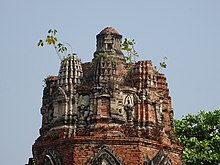Wat Mahathat Ayutthaya
The Wat Mahathat Ayutthaya ( Thai วัด มหาธาตุ พระนครศรีอยุธยา , Temple of the Great and Holy Relic ) is a Buddhist temple complex in Ayutthaya , central Thailand .
location
Wat Mahathat Ayutthaya is located in the city center of ancient Ayutthaya on Chi Kun Street and Naresuan Street in the northeast corner of Phra Ram Park.

Building history
According to the official Thai historiography, which is based on the investigation of the Royal Chronicles of Ayutthaya by Prince Damrong Rajanubhab , the story of Wat Mahathat begins around 1374, when King Borommaracha I had a temple built at this location, although it initially had a different name wore:
- “In the year of the tiger 736 CS , Somdet Phra Borommarachathirat and Phra Mahathera Thammakanlayan built the great, glorious, sacred, jeweled reliquary ( Phra Si Rattana Mahathat ) east of the palace ( the royal pediment of the lion ). It rose 19 wah in the air and was provided with a nine-limbed point that was another 3 wah high. "
His nephew and successor Ramesuan (1369-1370, 1388-1395) expanded the building into a large temple in 1384 when he was staying here as a monk between his throne offices. During this time the temple got its current name.
Jeremias van Vliet , Dutch merchant of the VOC , however, and chronicler wrote the foundation of the temple King Ramathibodi I. to. The same author wrote in 1636 that, in addition to Wat Mahathat, the temples Wat Phra Sri Sanphet , Wat Doen and Wat Chao Phraya Thai were among the four main temples in the whole country. The Supreme Patriarch of the Thai Buddhists resided at Wat Mahathat at that time. In addition, the temple was incredibly rich, "people say that a ruined kingdom can be restored with the riches under the Buddha statues of Wat Mahathat and Wat Si Sanphet". During his visit in 1596, Jaques de Coutre also counted the temple among the “three most important pagodas” of the city.
In 1631, during the reign of King Prasat Thong , the Golden Tower in Wat Mahathat suddenly collapsed "without storm, thunder or lightning". The king had it rebuilt immediately, but shortly before completion, during a thunderstorm, the scaffolding ("beautiful and durable made of bamboo poles") collapsed. The repair work could not be completed until two years later. The new prang was 1 sen and 5 wah (about 50 meters) high with a metal point six meters high. As early as 1637, the temple was restored and expanded on the occasion of the millennium ( CS 1000). At that time it consisted of a prang, which was surrounded by a covered, inwardly open gallery ( Phra Rabieng ) . To the east the rear wall of a viharn jutted into the gallery. A group of five chedis stood north and two more south of the viharn. The temple was painted by a Dutch artist around the year 1650 in the center of his painting of the capital Ayutthaya ( Iudea , now in the Rijksmuseum Amsterdam).
In the period after 1750, further structures must have been added, as they were not mentioned by a Sinhala delegation who visited the temple in 1750 and left a detailed report:
- the eight prangs with gilded tips outside the gallery,
- the low platform with 10 chedis on each side around the central prang,
- the prangs in each of the four corners on the upper platform,
- the extension of the central prang by four “arms”, each with a smaller prang.
Attractions
The main structure of Wat Mahathat was originally the high, central prang in the Khmer style. Most of the temple withstood arson by the Burmese conquerors , who captured Ayutthaya in 1767 and practically devastated it. The ruins that can be seen today are believed to date from the late 17th to late 18th centuries. The prang was in good condition for a long time, but collapsed again in 1911 during the reign of King Vajiravudh ( Rama VI , ruled 1910–1925) and was not rebuilt.
During the extensive reconstruction work carried out by the Thai government in Ayutthaya in 1956, a buried treasure chest was uncovered at the prang, which contained a Buddha relic in a golden urn, several golden Buddha statues of various sizes and others with gold and precious stones Items contained. These objects are now on display in the Ayutthaya National Chao Sam Phraya Museum.
swell
- HRH Prince Damrong Rajanubhab: A History Of Buddhist Monuments In Siam . Bangkok 1929, reprint by The Siam Society, Bangkok 1962, oh. ISBN
- Piriya Krairiksh: A Revised Dating of Ayudhya Architecture (I) . Article in Journal of the Siam Society, Vol. 80 Part 1, Bangkok 1992, ISSN 0857-7099 , online [1] (PDF, last accessed on October 31, 2012; 2.5 MB).
- Richard D. Cushman (David K. Wyatt Ed.): The Royal Chronicles Of Ayutthaya. The Siam Society, Bangkok 2000, ISBN 974-8298-48-5
literature
- Clarence Aasen: Architecture of Siam: A Cultural History and Interpretation . Oxford: Oxford University Press 1998. ISBN 983-56-0027-9 .
Web links
- To the building history - site of orientalarchitecture.com (in English)
- Extract from the Royal Chronicles of Ayutthaya (in English)
Coordinates: 14 ° 21 ′ 25 ″ N , 100 ° 34 ′ 3 ″ E




